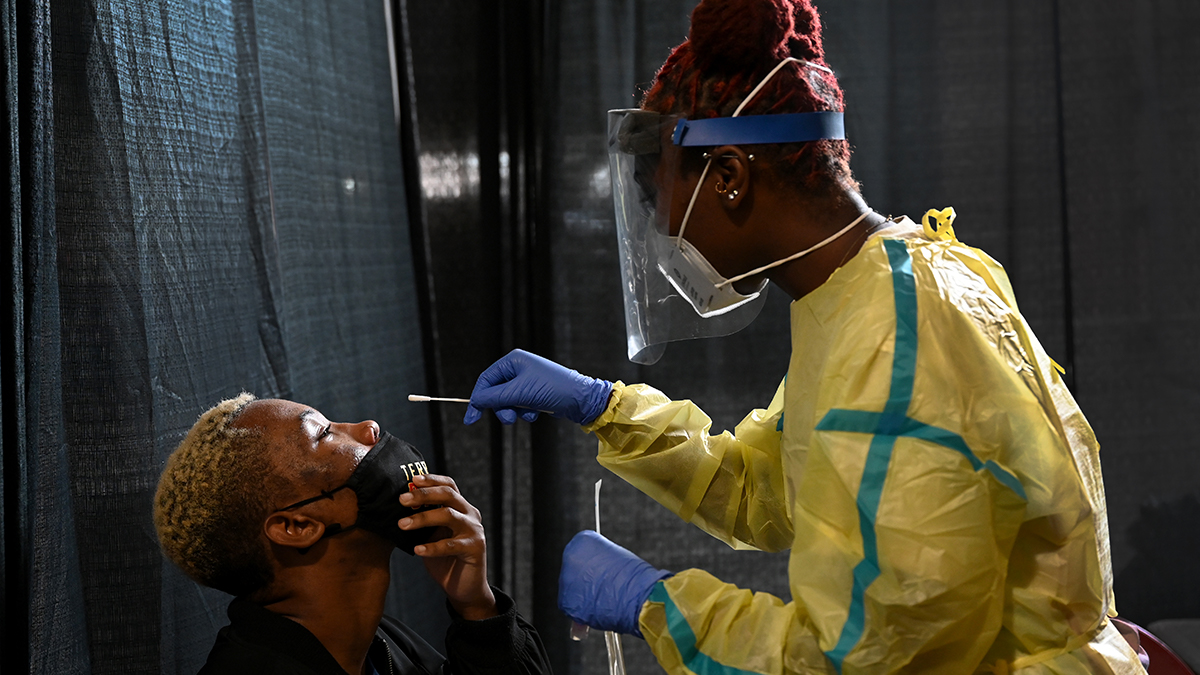The first day of early in-person voting during the coronavirus era is underway in Virginia, where long lines of mask-wearing citizens waited to cast their ballots weeks before Election Day.
Election officials extended the in-person voting window and expanded mail-in balloting to help citizens avoid lines, but Northern Virginians were impatient to cast their ballots.
Photos: Virginians Head to the Polls for Early Voting
Virginia has released the results of a serology test that was conducted over the summer.
Hispanic individuals, Northern Virginia residents and uninsured or Medicaid recipients were most likely to have antibodies that indicated a previous COVID-19 infection.
Overall, roughly 2.4% of adults studied over the summer had coronavirus antibodies. But that number was 10.2% among Hispanic people studied. The data also indicates as many as 4.4% of people in Virginia’s northern region have been exposed to coronavirus.
The American Academy of Pediatrics also weighed in on how long kids who catch coronavirus should wait before returning to sports practice or games.
Kids can gradually resume athletics once their symptoms have been gone for 14 days and a primary care doctor clears them. Furthermore, the APA recommends any athlete who had moderate symptoms undergo an electrocardiogram (EKG) because COVID-19 can damage the heart.
What the Data Shows
Across D.C., Maryland and Virginia, trends mostly held steady on Friday.
On Friday, D.C. added 62 new cases; Maryland added 543 and Virginia added 1,130.
Positivity rates have fallen to 2.3% in D.C., 3.2% in Maryland and 6.6% in Virginia.
In an encouraging sign, hospitalizations in Virginia are the lowest they have been in two months. Currently, 648 people are reported to be hospitalized with COVID-19.
D.C. announced it will be revising some of its coronavirus data reporting during a press conference on Thursday.
The old method of reporting community spread is set to be retired. DC Health Director LaQuandra Nesbitt said the model that was in use since the beginning of the pandemic may have confused the average person looking at the data.
The new main metric shared so the public can track community spread will be daily cases reported per 100,000 population.
“We believe that this metric is far easier and useful for the public to be able to follow along with,” Nesbitt said.
The map below shows the number of coronavirus cases diagnosed per 100,000 residents.
Coronavirus Cases in DC, Maryland and Virginia
COVID-19 cases by population in D.C. and by county in Maryland and Virginia
Source: DC, MD and VA Health Departments
Credit: Anisa Holmes / NBC Washington
Local Coronavirus Headlines
- D.C. Public Schools in mid-September began considering plans that could bring students back to in-person classes by Nov. 9, 2020. The city is also starting to plan how it will administer a COVID-19 vaccine once one is proven effective and made available. Read more.
- Prince George's County is allowing more businesses to open their doors and revised some of its coronavirus safety guidelines under its second phase of reopening. Read more.
- Seven popular nightlife spots near D.C.’s U Street Corridor will be shuttered next month. Read more.
- The Smithsonian is set to reopen four more museums to the public beginning this Friday.
- The University of Maryland began transitioning to in-person lessons on Monday after the school reported a low campus positivity rate of 0.7%.
- Some D.C. Public Schools students could be back in the classroom as early as this month, the mayor said. Read more.
- Up to 25,000 low-income students and families in D.C. are set to be provided free internet connections under a new initiative from Mayor Muriel Bowser. Here's what to know.
- What can sewage tell us about COVID-19 in our communities? Stafford County, Virginia, provides an example.
Reopening Tracker
- Prince George's County will allow tanning salons, banquet halls and other businesses to open with restrictions. It adjusted some other rules on Wednesday, too. Read more.
- Montgomery and Prince George's counties are among those that did not enter phase three with the state of Maryland. Here's a roundup of counties in our area.
- Maryland Gov. Larry Hogan said he has authorized all public schools in the state to begin “safely” reopening because state metrics on the coronavirus show improvements. The state “strongly suggests” that local school districts bring students back into schools but cannot force them to do so, Hogan said. Montgomery and Prince George's schools have both affirmed that they are not altering plans to hold classes online throughout the first half of the school year.
- Private and parochial schools in Maryland can choose when to reopen after a back-and-forth between county health officials and the governor. Read more.
- Prince George's County revisited its phase two reopening executive order due to an uptick in coronavirus cases, according to the county executive's office.
- Virginia entered phase three reopening on July 1, loosening restrictions on restaurants, stores, gyms and pools. Northam has said more restrictions could be implemented if cases continue to grow.
- D.C. entered phase two on June 22, allowing indoor dining, gyms, libraries and houses of worship to reopen with restrictions.
- Montgomery County entered phase two on June 19, reopening with restrictions gyms, houses of worship, indoor dining and retail.
How to Stay Safe
There are ways to lower your risk of catching coronavirus. Here are guidelines from the CDC:
- Wear a snug-fitting mask that covers your nose and mouth.
- Avoid being indoors with people who are not members of your household. The more people you are in contact with, the more likely you are to be exposed to COVID-19. If you are indoors with people you don’t live with, stay at least six feet apart and keep your mask on.
- Wash your hands often, especially after you have been in a public place.
Sophia Barnes, Andrea Swalec and Anisa Holmes contributed to this report





